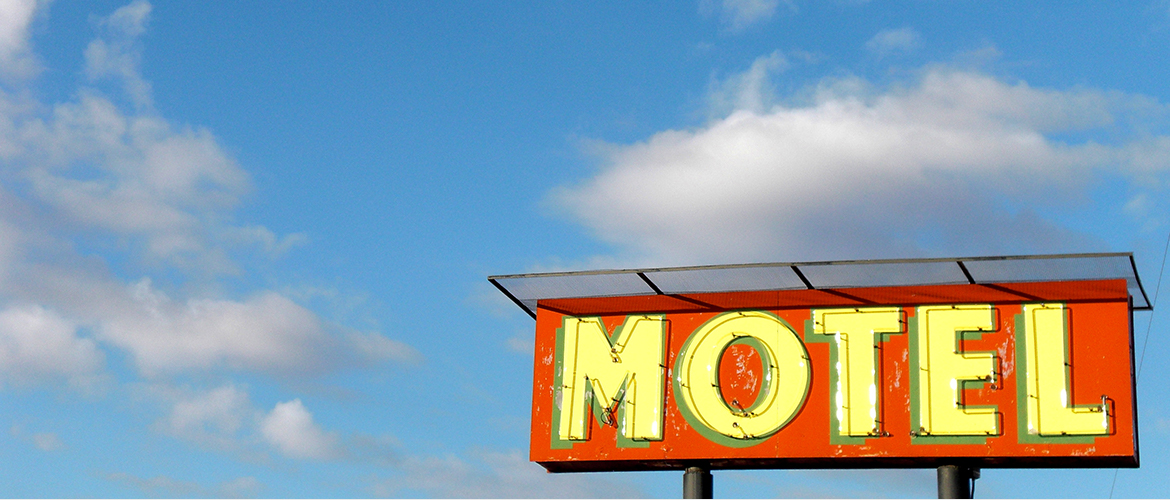No time to read? Listen to the podcast.
In the mid-1950s, guests at John Houghtaling’s frequent dinner parties had no idea they were in the presence of a man who was on the verge of pop culture immortality. They were just there to buy the pots and pans Houghtaling hawked using a let’s-party marketing gambit inspired by the success of that pop icon of the 1950s, Tupperware.
Houghtaling, a Kansas City, Missouri native and World War II vet, worked as a hotel bellman before landing his salesman’s job. He loved the work. Until he didn’t. And when he was offered the opportunity to sell something different, he jumped out of the frying pans and into vibrating mattresses.
It was probably the first guest-room amenity after the TV.
The wave of calm that rode through the fifties, fueled by post-War optimism and magic drugs like Miltown and Valium, made a wave of calm that rode through your bed a natural amenity for hotels and motels.
But Houghtaling discovered the shaking mechanism was unreliable, and repairing it meant taking apart the mattress, since all the working parts were buried inside.
The experience gave the inveterate tinkerer an idea. His customers shouldn’t need to buy a whole mattress just to get the benefits of a gentle massage. Eyeing a motor he salvaged from a junk yard, Houghtaling set out to solve the problem.
Three hundred motors later he found the right formula for vibrating a mattress without throwing its occupant onto the floor. In 1958 he patented a device that became, along with convertibles and Route 66 roadsigns, an icon of the open road culture of the 1950s and 60s.
He called it Magic Fingers.
For a quarter you could plop yourself down on a motel bed and enjoy fifteen minutes of good vibrations, courtesy of Houghtaling’s invention that gently shook the bed frame. Houghtaling wasn’t the first person to figure out how to make a mattress vibrate. The U.S. Patent Office lists patents for similar devices dating back to 1896. But Houghtaling’s invention is the most well known.
“[The Magic Fingers device was] probably the first guest-room amenity after the TV,” wrote Ed Watkins, editor of Lodging Hospitality magazine. Houghtaling sold them as a health aid and comforter, and by the 1970s you could find them in over 250,000 units across the country.
Magic Fingers quickly became part of the fabric of road trips taken by uncounted numbers of traveling salesmen, as well as by parents and kids on family vacations, (the latter would crawl under the covers to shriek and giggle at this cut-rate thrill ride).
For twenty years Magic Fingers took Houghtaling on his last, great ride, making hundreds of thousands of dollars for him, his franchisees and motel operators. Until, as songwriter Don McClean wrote, the music died.
“Now you don’t sell a room for $100 and ask [guests] to put a quarter in a machine in their room,” Susan T. Port wrote in the Palm Beach Post,* quoting the general manager of a local Holiday Inn. That those coin boxes full of quarters offered vandals a way to become uninvited partners in Magic Finger’s profits didn’t help burnish the devices’ image, either.
More than anything, though, what hastened Magic Fingers’ decline was the device’s success. By the late seventies, many of the motels that once proudly welcomed travelers had gone to seed or — worse — into corporate ownership.
And with them, Magic Fingers’ reputation.
“Many of the national chains, like Motel 6, discarded the units because they saw them as carrying a seedy truck stop taint,” wrote Tom Sowa at Spokesman.com.
As late as 1990 American Hotel Register Co. still listed Magic Fingers in its catalog of motel and hotel equipment. The firm claimed that a million guests got a Magic Fingers buzz every month. Only Magic Fingers was no longer an amenity. It was, in the words of product manager Tracy Slaughter, “a gimmick.”**
Instead, motels began offering Wi-Fi, health club memberships and a host of 21st century accoutrements from gourmet food delivery to branded mattresses. Motel owners found no room in their rooms for gimmicks. Today, nary a vactioner or road warrior reaches for a roll of quarters when packing for a trip.
Unless …
Unless their travels take them to the northern tip of Idaho’s panhandle and the city of Coeur d’ Alaine.
There, in all of the rooms in the Flamingo Hotel, they will still find beds equipped with original Magic Fingers. The slogan “It quickly takes you into the land of tingling and relaxation and ease,” is still stenciled on the coin box.
Despite living in a more complex world, it’s comforting to know the good vibrations of the sixties still live on today.
**Tom Philip, “Magic Fingers still providing a buzz,” in the Chicago Tribune Chicago, Ill. August 26, 1990
Start your Sunday with a laugh. Read the Sunday Funnies, fresh humor from The Out Of My Mind Blog. Subscribe now and you'll never miss a post.
Mind Doodle…
Houghtaling had an idea for a crude credit card system that would replace the money box. While his Magic Fingers were right for the times, his payment card predated modern credit cards and was too far ahead of its time to catch on. The boxes remained as an inviting target.

Hey fun for the whole family… and far safer for a little kid than bouncing on the bed.
Hi Nick…
You’re absolutely right.
Now, if only there were some sort of Magic Fingers device on airplanes to keep little kids from kicking the back of my seat.
–jay
Oh, yes, I remember Magic Fingers!
Hi Nancy…
Just to be sure … we’re talking about Magic Fingers, John Houghtaling’s invention, not magic fingers belonging to … never mind.
–jay